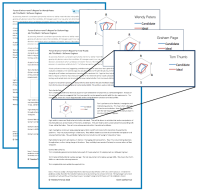One of many articles on recruitment and selection
Deterministic Recruitment: getting recruitment right first time
Written by John Berry on 31st May 2017. Revised 17th February 2025.
3 min read
 Recruitment starts with a manager of a firm stating what qualities they want in a new recruit. A recruitment consultant then perhaps instigates a search to find suitable candidates. There’s an issue though – how does one specify what’s needed?
Recruitment starts with a manager of a firm stating what qualities they want in a new recruit. A recruitment consultant then perhaps instigates a search to find suitable candidates. There’s an issue though – how does one specify what’s needed?
How does that manager express the traits and competencies of candidates such that the search turns up truly viable candidates? If the search turns up less-than-ideal folk and the interview process selects the ‘best of a bad bunch’, that wastes everyone’s time and hits the firm’s turnover and profits. How then does one avoid time wasting and get a viable pool of candidates right from the start?
A well-developed specification
There’s a parallel here with the design and development of product. No firm starts product design without a well-developed specification considering all the other products and services offered by the firm and offered by competitors. So using that analogy, what’s the equivalent of a specification in recruitment and selection?
First let’s consider what it’s not. It’s not a simple discussion between recruitment agent and manager. That might be part of it but there is a much more precise approach that mirrors the world of product design. To determine what it is, it’s worth looking at the world of quality and quality in design to ask ‘what gives us a quality product?’ The answer is to specify what’s needed, design just that and then prove that it’s done. That’s determinism at its best.
Defining human behaviour
Over the past century, those in organisational psychology (including human resource management consultants) have developed accurate ways of describing people and the behaviours that they bring to the workplace. These behaviours then cause outcomes in the firm’s operations. It’s these outcomes, and the behaviours and competencies that cause them, that we need to specify.
So how do we proceed? Everything starts with the P&L account and the business plan that the firm is committed to. A sub-set of that business plan is the manpower plan containing the competency framework. Competencies and behaviours lead to outcomes for the firm through the motivation of management. A competency framework defines all the competencies needed in the firm. If someone new is needed, their competencies will be apparent. Defined competencies and behaviours spawn a specification for the person to be recruited.
Deterministic recruitment: getting recruitment right first time
And what do we mean by competencies and behaviours? Competencies are simply what a person is able to do while at work - so defined by a set of statements starting "the jobholder shall be able to...". Behaviours are bound up in an employee’s traits and abilities, both definable using personality and ability profiles that describe traits like conscientiousness and then describing abilities that measure how folk think, learn and solve problems.
Continuing the design analogy, if you can say what you want in a job and define the ‘specification’ of the person who might fill it, the design of the ‘person’ (the search and selection in the recruitment case) will be a whole load more successful – deterministic in fact!
In deterministic recruitment the specification of the person needed is fundamental to success. Call us for more of what we can do to ensure you get recruitment right first time.